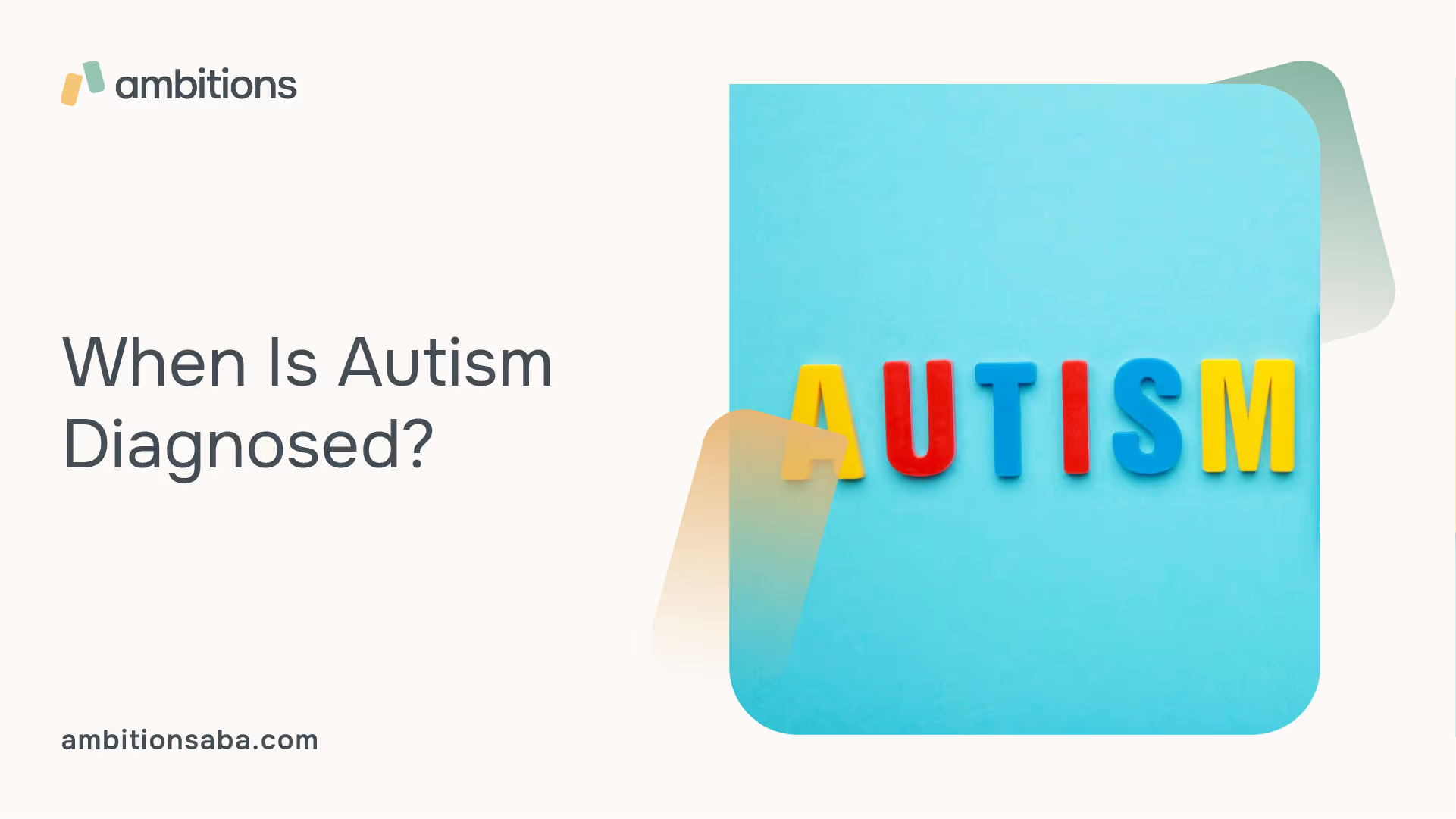Unlocking Social Understanding Through ABA Therapy
When Is Autism Diagnosed?
Autism Spectrum Disorder (ASD) is a neurodevelopmental disorder characterized by difficulties in social interaction, communication, and repetitive patterns of behavior. It affects individuals across a wide range or "spectrum" of functioning. Understanding the key aspects of ASD is crucial for parents seeking an autism spectrum disorder diagnosis for their child.

What is Autism Spectrum Disorder?
Autism Spectrum Disorder (ASD) is a complex condition that affects how a person perceives and interacts with the world around them. It is a lifelong condition that typically emerges in early childhood and persists into adulthood.
ASD is characterized by challenges in social communication and interaction. Individuals with ASD may have difficulty understanding and using nonverbal cues, such as facial expressions and body language. They may also struggle with developing and maintaining relationships with others.
In addition to social difficulties, individuals with ASD often exhibit restricted, repetitive patterns of behavior, interests, or activities. This can manifest as repetitive movements (e.g., hand flapping), insistence on sameness, or intense interests in specific topics.
It's important to note that autism is a spectrum disorder, meaning that there is significant variability in the severity and presentation of symptoms among individuals. Some individuals with ASD may have exceptional abilities or strengths in certain areas, such as music or mathematics.

Signs and Symptoms of Autism Spectrum Disorder
Recognizing the signs and symptoms of ASD is crucial for early identification and intervention. While each individual with ASD is unique, there are some common behaviors and characteristics that may indicate the presence of the disorder.
Early signs of autism can often be observed in infancy, such as a lack of eye contact, limited or no response to their name, and delayed speech development. It's important to note that these signs may not be definitive indicators of ASD, but they can warrant further evaluation by a healthcare professional.
As children with ASD grow older, other signs and symptoms may become more apparent. These can include difficulties with social interactions (e.g., difficulty understanding emotions or maintaining conversations), repetitive behaviors (e.g., rocking back and forth), and intense interests in specific topics.
If you suspect that your child may have autism, it's important to consult with a healthcare professional who specializes in autism diagnosis. They will conduct a comprehensive evaluation to assess your child's development, behavior, and communication skills. This evaluation may involve standardized tests, observations, and interviews with parents and caregivers.
Understanding the basics of ASD, including its definition and common signs and symptoms, is the first step towards seeking an autism spectrum disorder diagnosis. By being aware of the early signs and seeking professional guidance, parents can ensure that their child receives the support and resources they need.
The Diagnostic Process
Getting a timely and accurate diagnosis for autism spectrum disorder (ASD) is crucial in order to provide appropriate support and intervention for individuals on the spectrum. The diagnostic process involves several steps, including early warning signs recognition, screening and evaluations, and a multidisciplinary assessment.
Early Warning Signs
Recognizing the early warning signs of autism is the first step towards seeking a diagnosis. While the signs can vary from person to person, there are some common indicators that parents should be aware of. These may include delayed speech and language skills, limited social interactions, repetitive behaviors, and sensory sensitivities. It's important to note that early signs of autism may appear as early as 6 to 18 months of age.
Screening and Evaluations
If parents or caregivers observe potential signs of autism in their child, the next step is to undergo screening and evaluations. This typically involves a comprehensive assessment by healthcare professionals, such as pediatricians, developmental pediatricians, and psychologists. These evaluations may include observations of the child's behavior, interviews with the parents, and standardized tests to assess developmental milestones and social communication skills. Screening tools like the Modified Checklist for Autism in Toddlers (M-CHAT) may also be used to gather additional information.
Multidisciplinary Assessment
To reach a formal diagnosis of autism spectrum disorder, a multidisciplinary assessment is conducted. This involves a team of professionals from various fields, such as pediatricians, psychologists, speech and language therapists, and occupational therapists. The assessment may include further observations, interviews, and specialized tests to gather a comprehensive understanding of the individual's strengths and challenges. The team collaborates to evaluate the individual's developmental history, social interactions, communication skills, and behavior patterns. This comprehensive approach helps ensure an accurate diagnosis and guides the development of an appropriate intervention plan.
To make a diagnosis of autism spectrum disorder, professionals follow specific criteria outlined in the Diagnostic and Statistical Manual of Mental Disorders (DSM-5). This manual provides a standardized set of criteria for diagnosing ASD, including the presence of social communication difficulties and restricted, repetitive patterns of behavior.
The diagnostic process for autism spectrum disorder involves the collaboration of various professionals, each bringing their expertise to assess and understand the individual's unique profile. By recognizing the early warning signs, undergoing screenings and evaluations, and engaging in a multidisciplinary assessment, parents and caregivers can take the necessary steps towards obtaining a diagnosis and accessing appropriate support and resources for their child.
Diagnostic Tools and Criteria
To accurately diagnose Autism Spectrum Disorder (ASD), professionals rely on specific diagnostic tools and criteria. These tools and criteria help in assessing the presence and severity of ASD symptoms. In this section, we will explore the key diagnostic tools and criteria used in the diagnosis of ASD.
DSM-5 Criteria for Autism Spectrum Disorder
The Diagnostic and Statistical Manual of Mental Disorders, Fifth Edition (DSM-5), is a widely accepted diagnostic manual used by mental health professionals. It provides specific criteria for diagnosing various mental health conditions, including Autism Spectrum Disorder.
The DSM-5 outlines two core domains that must be present for an ASD diagnosis: persistent deficits in social communication and social interaction, and restricted, repetitive patterns of behavior, interests, or activities. Additionally, the symptoms must be present in early childhood, even if they may not become fully manifest until later in life.
Autism Diagnostic Observation Schedule (ADOS)
The Autism Diagnostic Observation Schedule (ADOS) is a comprehensive, standardized assessment tool used to evaluate social and communicative behaviors associated with ASD. It is administered by trained professionals in a structured and interactive setting.
During the ADOS assessment, the professional engages the individual in various activities and social scenarios to observe their behavior and communication skills. This helps in assessing the presence and severity of ASD symptoms, and aids in making an accurate diagnosis.
Autism Diagnostic Interview-Revised (ADI-R)
The Autism Diagnostic Interview-Revised (ADI-R) is a semi-structured interview conducted with the parents or caregivers of individuals suspected of having ASD. It is designed to gather detailed information about the individual's early developmental history and current behavior.
The ADI-R covers various domains, including communication, social interaction, and repetitive behaviors. By gathering information from caregivers who have observed the individual's behavior over an extended period, the ADI-R provides valuable insights into the presence and severity of ASD symptoms.
These diagnostic tools, along with clinical observations and assessments, help professionals in accurately diagnosing Autism Spectrum Disorder. It's important to consult with qualified professionals, such as developmental pediatricians, psychologists, and psychiatrists, who are experienced in using these tools to ensure an accurate assessment.
Understanding the diagnostic tools and criteria used in the diagnosis of ASD can provide parents with valuable insights into the process. If you suspect your child may have ASD, it is crucial to seek a comprehensive evaluation from qualified professionals. Early identification and intervention can make a significant difference in the long-term outcomes for children with ASD.
Professionals Involved in the Diagnosis
When it comes to diagnosing Autism Spectrum Disorder (ASD), a team of professionals with specialized expertise plays a vital role in the process. The following professionals commonly contribute to the diagnosis of ASD:
Pediatricians and Primary Care Providers
Pediatricians and primary care providers are often the first point of contact for parents who suspect their child may have ASD. They play a crucial role in identifying early warning signs and referring families to specialists for further evaluation. These healthcare professionals are knowledgeable about child development and can provide initial guidance and support.
Developmental Pediatricians
Developmental pediatricians are doctors who specialize in the developmental and behavioral aspects of children. They have in-depth knowledge of the diagnostic criteria for ASD and conduct comprehensive evaluations to determine if a child meets the criteria. Developmental pediatricians often collaborate with other professionals to gather information from multiple sources and provide a comprehensive assessment.
Psychologists and Psychiatrists
Psychologists and psychiatrists are mental health professionals who can diagnose ASD through the use of standardized assessments and clinical interviews. They evaluate a child's behavior, social interactions, and communication skills to determine if the symptoms align with the criteria for ASD. Psychologists and psychiatrists may work in collaboration with other professionals to ensure a thorough evaluation.
Speech and Language Therapists
Speech and language therapists (SLTs) play a crucial role in assessing the communication abilities of individuals suspected of having ASD. They evaluate a child's language development, social communication skills, and speech patterns. SLTs use various assessments and observations to contribute valuable information to the diagnostic process. Additionally, they can provide ongoing therapy to help individuals with ASD improve their communication skills.
Occupational Therapists
Occupational therapists (OTs) focus on evaluating and addressing the sensory and motor challenges that individuals with ASD may experience. They assess a child's fine motor skills, sensory processing, and daily living skills. OTs contribute valuable insights into a child's sensory and motor development, which aids in the diagnosis of ASD. They may also provide therapy to improve a child's functioning and independence.
The involvement of these professionals in the diagnosis of ASD ensures a comprehensive assessment from different perspectives. By working together, they bring their expertise to accurately evaluate and diagnose individuals with ASD, enabling appropriate interventions and support.
Support and Resources
Receiving a diagnosis of autism spectrum disorder (ASD) for your child can be overwhelming. However, it's important to remember that there are numerous support and resources available to assist you and your family on this journey. Here, we will explore some of the key support options and resources that can help you navigate the challenges of raising a child with autism.
Early Intervention Services
Early intervention is crucial for children with autism. These services focus on providing specialized support and therapy to help children develop important skills and reach their full potential. Early intervention programs typically involve a combination of therapies tailored to meet the unique needs of each child.
Some common early intervention services for children with autism include:
- Applied Behavior Analysis (ABA) therapy: ABA therapy is a structured and evidence-based approach that focuses on teaching skills, reducing challenging behaviors, and promoting positive behavior changes.
- Speech therapy: Speech therapy helps children improve their communication skills, including speech articulation, language comprehension, and social communication.
- Occupational therapy: Occupational therapy focuses on enhancing a child's ability to perform everyday tasks, such as fine motor skills, self-care skills, and sensory integration.
- Social skills groups: These groups provide opportunities for children with autism to practice and develop social interaction skills in a supportive and structured environment.
Therapy Options for Children with Autism
In addition to early intervention services, there are various therapy options available to support children with autism. These therapies aim to address specific challenges commonly associated with ASD and promote overall development and well-being.
Here are some therapy options commonly used for children with autism:
Support Organizations for Parents of Children with Autism
Connecting with support organizations can be immensely helpful for parents of children with autism. These organizations offer a wealth of resources, guidance, and a sense of community. They often provide educational materials, online forums, support groups, and advocacy services.
Here are some prominent support organizations for parents of children with autism:
- Autism Society: A national organization that provides support, advocacy, and resources for individuals with autism and their families.
- Autism Speaks: A leading autism advocacy organization that promotes awareness, research, and support for individuals with autism and their families.
- National Autism Association: An organization dedicated to providing support, education, and resources for individuals with autism and their families.
- Local Autism Support Groups: Many local communities have support groups specifically catered to parents of children with autism. These groups offer a safe space to share experiences, gain insights, and receive emotional support.
By availing yourself of early intervention services, exploring therapy options, and connecting with support organizations, you can access the necessary resources and support to help your child thrive. Remember, you are not alone on this journey, and there are people and organizations ready to assist you every step of the way.
FAQs
Can autism be diagnosed in adults?
Yes, autism can be diagnosed in adults. While diagnosis is more common in childhood, many individuals with autism are not diagnosed until later in life. Symptoms may become more noticeable as a person enters adulthood and faces new social and occupational challenges.
What should I do if I suspect my child has autism?
If you suspect that your child has autism, it is important to speak with your pediatrician or a specialist who can evaluate your child's behavior and development. Early intervention can make a significant difference in the lives of individuals with autism, so it is important to seek help as soon as possible.
Are there any medical tests for diagnosing autism?
There are no medical tests that can diagnose autism on their own. However, hearing and vision screenings, genetic testing, and other assessments may be used as part of the diagnostic process.
Can girls have autism too?
Yes, girls can have autism too. While boys are diagnosed with autism more frequently than girls, recent research suggests that the condition may be underdiagnosed in girls due to differences in how they present symptoms.
Is there a cure for autism?
There is no cure for autism, but early intervention and appropriate support can improve outcomes for individuals with the condition. Treatment may include behavioral therapy, speech therapy, occupational therapy, medication management, and other approaches tailored to an individual's needs.
Summary
In conclusion, autism is a complex disorder that can be diagnosed through a variety of assessments and evaluations. While early diagnosis and intervention can make a significant difference in the lives of individuals with autism, there is no set timeline for when autism is diagnosed. If you have concerns about your child's development, it is important to speak with your pediatrician or a specialist who can provide appropriate care and support. Remember, every child is unique, and with the right resources and support, individuals with autism can thrive and lead fulfilling lives.

